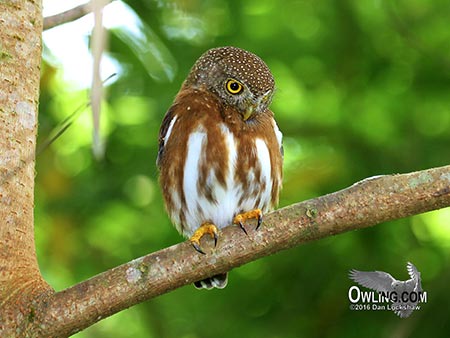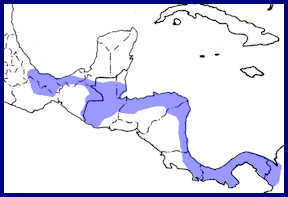
Central American Pygmy-Owl
A Reference for North and Central American Owls
The Central American Pygmy-Owl has a range that stretches from Veracruz, Mexico to northwestern Ecuador in western South America. Very little is known about this pygmy-owl that was once heaped in a mass of pygmy-owls called “Least Pygmy-Owls”. Central American Pygmy-Owl is readily distinguished from the other pygmy-owls of Central America with its grayish-brown colored head contrasting with its rich brown unspotted back. There is no known overlap with any other pygmy-owl within its Central American range and habitat. Here you can find photos, a Central American range map and information to help identify and enjoy this beautiful owl. The Field Notes section includes information on nesting, habitat, behavior, vocalizations, description and identification.
To jump immediately to any of these sections use the Page Tabs below.
This is the standard territorial call. It consists of a series of hollow ringing notes given at three notes per second. Sets of notes about five seconds in overall length.
There are no videos at this time. Please check back with us.
FIELD NOTES
Central American Pygmy-Owl – Glaucidium griseiceps
 The Central American Pygmy-Owl was formerly treated as a race of the Least Pygmy-Owl (Glaucidium minutissimum) which is restricted to E. Brazil and vocally different. No divisions in race are currently recognized although three have been suggested:
The Central American Pygmy-Owl was formerly treated as a race of the Least Pygmy-Owl (Glaucidium minutissimum) which is restricted to E. Brazil and vocally different. No divisions in race are currently recognized although three have been suggested:
1. S. Mexico – G. g. occultum
2. Guatemala, Belize, Honduras – G. g. griseiceps
3. Costa Rica, Panama – G. g. rarum
Habitat
This is a small sized owl (5 1/2 – 6 1/4 in. in length) as are all pygmy-owls. It inhabits humid tropical forests, adjacent secondary forests, and humid semiopen bushland from sea level up to 1300m. It may also be found in mature or abandoned cacao plantatations.It is often found in the canopy and edge of wet forests. There is no overlap in habitat between the Central American Pygmy-Owl and the similiar species found in its range.
Identification
It is not known to occur in different color morphs as many of the other species of pygmy-owl are. The Central American Pygmy-Owl is fairly unique in its markings and coloration. The first thing that is noticed is that it has a brownish-grey head (nape and crown) that contrasts with a rich brown unspotted back. The head and nape are distinctly spotted off-white with some trailing spotting into the upper chest. Tail much less barred than in other pygmy-owls with only 2-3 broken tail bars on a dark brown, short, tail. The underside of this owl has rofous-brown markings on a white base. The upper chest is solid rufous-brown with the previously mentioned trailing and minor white spotting from the crest and nape. Rufous-brown marking trail down along the flanks and both sides of the chest in wide streaks leaving a center white streak down the center of the chest from the lower throat into the white belly. Eyes are yellow and it has short white brows.
Similar Species
Similar species: Ferruginous Pygmy-Owl has streaking on the forehead and nape rather than spots. Costa Rican Pygmy-Owl has a longer tail, spotted upper parts and evenly colored head/back differing from the Central American Pygmy-Owl’s largely unspotted back and contrasting brown-grey head. The Mountain Pygmy-Owl has a longer tail and distictive white throat that is missing on the Central American Pygmy-Owl.
Food
The Central American Pygmy-Owl, like many of its pygmy-owl cousins, preys largely on other birds. Its diet also includes insects, lizards and other small vertebrates. It hunts by sitting at a perch and scanning for prey, attacking with a swift dash and pounce. Unlike most pygmy-owls this owl is active at night. Although it is still considered a primarily diurnal species it is not unusual to encounter this owl vocalizing at night.
Vocalizations
Its call generally consists of a series of hollow ringing notes given at three notes per second. Sets of notes often start at one to one and one half seconds in length and progressively extend to a consistent five seconds in overall length. The sets are given at variable intervals.
Breeding
Breading: Lays 2-4 eggs in April through May in tree cavity, abandoned woodpecker holes and maybe even openings in old termite nests in the trees. Nesting is poorly known and needs further research.
